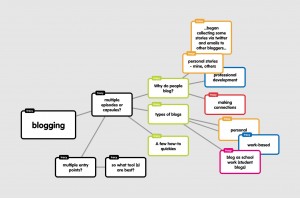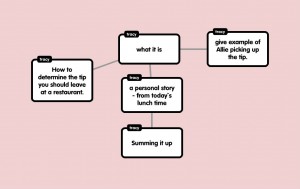2nd day of a 2-day workshop facilitated by Avi and Marc-Andre around the concept of flipping the classroom. Here are my notes from Day 1.
Don’t you hate being late? I do…this morning I ran in late…didn`t know how to connect to the internet so began writing on a notepad and am now pasting in, to be added to. I hate being late. Somehow I ended up on a long, windy road by the water to get here. And once I got here I could see the autoroute close by so there has to be a quicker method. Ah well. then couldn`t find parking and was lost looking for the entrance to the building…
en tous cas…here I am. Once again, these are my notes. I’ve highlighted certain key ideas that interest me in particular.
Talking around how to intro this to teachers
– do we show teachers how to use this even if they are not teaching program?
Or should we say you need to be teaching program to work with me?
(program being current and / or reformed curriculum…)
Pushing Hands
as consultants we are working at different levels with different teachers
important nuance between meeting educators where they are and guiding them to a brighter future ( within their own goals, a bit past their comfort zone )– reminds me of pushing hands exercise
Pushing hands works to undo a person’s natural instinct to resist force with force, teaching the body to yield to force and redirect it.
With pushing hands, the two participants end up looking together in the same direction. I like this and use this as a model for the work I do with teachers. Important to note that the direction is not always the one I envisioned.
my goals for today – learning and finessing my technical skills
My experience can become a model for the work I do with educators.
(did not really happen. I learned a few new tools, but spent the majority of my time thinking, talking, planning…)
In making videos…Educators often recreate a traditional classroom lecture (standing in front of white board, lecturing)
(Question asked to the group from Avi) How would we approach working with teachers to avoid this? (our answers, below)
- Stay out of the classroom – if you are in the classroom there needs to be action (using the SMARTboard, demonstrating…)
- maybe no face shots
- maybe recording a sentence at a time
- structuring the process – creating a guideline (mindmap…structure of some sort)
- script
Task today – produce a capsule on something that we want, that will be useful in our practice
We were asked – what would we prefer, get little intros to different tools first and then start to create or start the creation process 1st (planning the concept) …
I think we informally decided to look at diff`t tools first…yes, it was informal and then formalized.
We said we need to see tools to help form the content and suggested that at the end of the 1st day or section of this atelier they should provide a quicky – maybe 10-15 minutes of introducing tools – 10 tools in 10 minutes kind of thing.
(I`m taking notes only on what interests me, what is available to me with the tools I have or are available at the centres where I work.)
Explain Everything (iPad app) – like educreations or show me but in slides and seems more editable. Can be exported to mp4, which can then be manipulated with sound or other editing…
Jing – remember Jing? I think I used it a few times a couple of years ago…is this possible? Yes, it is. I explored it then gave it up because it is not linux friendly.
PowerPoint – we (I) am so quick to dismiss powerpoint because it seems to have been used to death but it’s the boring, one-dimensional side of PowerPoint that has been used to death. The reality is that it is available to all of our teachers. And there are many things that can be done with it. I need to explore this further…
I started to think about my task – created a popplet once again. Not sure how much I love popplets BUT they are so easy to do.

Discussion around the 90/10 idea – the reality might be 99/1… (teachers who flip their classrooms to use 90% found video/resources and 10% self-created)
Criticism of flipped classroom
Lisa Nielson: Five Reasons I`m Not Flipping over Flipped Classroom
Personal reaction – I felt her 5 reasons were based on an assumption that flipping the classroom is 1 thing – homework in class, lecture at home. I see flipping to be very different. Anything that gets us away from using our valuable face time with students in a way that promotes passivity in learning is part of a flipped process.
In other words – if I am allowing students to access theoretical material (the lecture, the bits of knowledge) from a place other than me, either at home the night before or in class via computers or even their own phones or whatever other sources work, and then using our face time to apply, create, collaborate, etc.. then I am ‘flipping’.
In that case, I’ve been flipping for a while…I used to say it was because I was a lazy teacher and didn’t want to prepare a lecture but really it was because I didn’t want to waste my time reinventing the wheel. I wanted to work with my students.
Biggest Takeaway for me
Seems to be in the area of how can I use this in Professional Development? I see this concept as being a wonderful, powerful way to make PD more meaningful, more relevant. I’ve started to look at this more on a separate page on this blog, Resources for Flipped PD. Not sure if that is where it will stay but that is where it lives for now.


